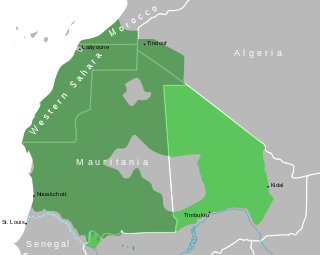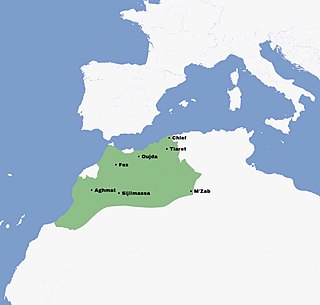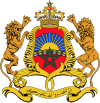The history of human habitation in Morocco spans since the Lower Paleolithic, with the earliest known being Jebel Irhoud. Much later Morocco was part of Iberomaurusian culture, including Taforalt. It dates from the establishment of Mauretania and other ancient Berber kingdoms, to the establishment of the Moroccan state by the Idrisid dynasty followed by other Islamic dynasties, through to the colonial and independence periods.

Demographic features of the population of Morocco include population density, ethnicity, education level, health of the populace, economic status, religious affiliations and other aspects of the population. The population of Morocco in 2021 is 37.271 million.

North Africa is a region encompassing the northern portion of the African continent. There is no singularly accepted scope for the region, and it is sometimes defined as stretching from the Atlantic shores of the Western Sahara in the west, to Egypt and Sudan's Red Sea coast in the east.

Berbers or the Berber peoples, also called by their contemporary endonym Amazigh or Imazighen, are a diverse grouping of distinct ethnic groups indigenous to North Africa who predate the arrival of Arabs in the Arab migrations to the Maghreb. Their main connections are identified by their usage of Berber languages, most of them mutually unintelligible, which are part of the Afroasiatic language family. They are indigenous to the Maghreb region of North Africa, where they live in scattered communities across parts of Morocco, Algeria, Libya, and to a lesser extent Tunisia, Mauritania, northern Mali and northern Niger. Smaller Berber communities are also found in Burkina Faso and Egypt's Siwa Oasis.

The Maghreb, also known as the Arab Maghreb and Northwest Africa, is the western part of the Arab world. The region comprises western and central North Africa, including Algeria, Libya, Mauritania, Morocco, and Tunisia. The Maghreb also includes the disputed territory of Western Sahara. As of 2018, the region had a population of over 100 million people.

Beni Ḥassan is a Bedouin Arab tribe which inhabits Western Sahara, Mauritania, Morocco and Algeria. It is one of the four sub-tribes of the Beni Maqil who emigrated in the 11th century from South Arabia to the Maghreb with the Bani Hilal and Banu Sulaym Arab tribes. In the 13th century, they took the Sanhaja territories in the southwest of the Sahara. In Morocco, they first settled, alongside their Maqil relatives, in the area between Tadla and the Moulouya River. The Sous Almohad governor called upon them for help against a rebellion in the Sous, and they resettled in and around that region. They later moved to Mauritania, and from the 16th century onwards, they managed to push back all black Mauritanians southwards to the Senegal Valley river. The Beni Hassan and other warrior Arab tribes dominated the Sanhaja Berber tribes of the area after the Char Bouba war of the 17th century. As a result, Arabs became the dominant ethnic group in Western Sahara and Mauretania. The Bani Hassan dialect of Arabic became used in the region and is still spoken, in the form of Hassaniya Arabic. The hierarchy established by the Beni Hassan tribe gave Mauritania much of its sociological character. That ideology has led to oppression, discrimination and even enslavement of other groups in Mauritania.

The Banu Hilal was a confederation of Arab tribes from the Najd region of the central Arabian Peninsula that emigrated to the Maghreb region of North Africa in the 11th century. Masters of the vast plateaux of the Najd, they enjoyed a somewhat infamous reputation, possibly owing to their relatively late conversion to Islam and accounts of their campaigns in the borderlands between Iraq and Syria. When the Fatimid Caliphate became the rulers of Egypt and the founders of Cairo in 969, they hastened to confine the unruly Bedouin in the south before sending them to Central North Africa and then to Morocco.
The Zenata are a group of Berber tribes, historically one of the largest Berber confederations along with the Sanhaja and Masmuda. Their lifestyle was either nomadic or semi-nomadic.

The Maghrawa or Meghrawa were a large Zenata Berber tribal confederation whose cradle and seat of power was the territory located on the Chlef in the north-western part of today's Algeria, bounded by the Ouarsenis to the south, the Mediterranean Sea to the north and Tlemcen to the west. They ruled these areas on behalf of the Umayyad Caliphate of Cordoba at the end of the 10th century and during the first half of the 11th century.

The Idrisid dynasty or Idrisids were an Arab Muslim dynasty from 788 to 974, ruling most of present-day Morocco and parts of present-day western Algeria. Named after the founder, Idris I, the Idrisids were an Alid dynasty descended from Muhammad through his grandson Hasan. The Idrisids are traditionally considered to be the founders of the first Moroccan state, setting the stage for subsequent dynasties and states centered in this region. Their reign played an important role in the early Islamization of Morocco and also presided over an increase in Arab immigration and Arabization in major urban centers.

The tribes of Arabia or Arab tribes denote ethnic Arab tribes originating in the Arabian Peninsula. These tribes trace their ancestry to one of the two Arab forefathers, Adnan or Qahtan.

The BanuMa'qil is an Arab nomadic tribe that originated in South Arabia. The tribe emigrated to the Maghreb region of North Africa with the Banu Hilal and Banu Sulaym tribes in the 11th century. They mainly settled in and around the Saharan wolds and oases of Morocco; in Tafilalt, Wad Nun, Draa and Taourirt. With the Ma'qil being a Bedouin tribe that originated in the Arabian Peninsula, like Banu Hilal and Banu Sulaym, they adapted perfectly to the climatic desert conditions of the Maghreb, discovering the same way of life as in the Arabian Peninsula. The Ma'qil branch of Beni Hassan which came to dominate all of Mauritania, Western Sahara, south Morocco, and south-west Algeria, spread the Hassaniya Arabic dialect, which is very close to classical Arabic.
The Banu Ifran or Ifranids, were a Zenata Berber tribe prominent in the history of pre-Islamic and early Islamic North Africa. In the 8th century, they established a kingdom in the central Maghreb, with Tlemcen as its capital.

Arab-Berbers are a population of the Maghreb, a vast region of North Africa in the western part of the Arab world along the Mediterranean Sea and the Atlantic Ocean. Arab-Berbers are people of mixed Arab and Berber origin, most of whom speak a variant of Maghrebi Arabic as their native language, some also speak various Berber languages. Many Arab-Berbers identify primarily as Arab and secondarily as Berber.
Maghrebi Arabs or North African Arabs are the inhabitants of the Maghreb region of North Africa whose ethnic identity is Arab, whose native language is Arabic and trace their ancestry to the tribes of the Arabian Peninsula. This ethnic identity is a product of the centuries-long Arab migration to the Maghreb since the 7th century, which changed the demographic scope of the Maghreb and was a major factor in the ethnic, linguistic and cultural Arabization of the Maghreb region. The descendants of the original Arab settlers who continue to speak Arabic as a first language currently form the single largest population group in North Africa.

Moroccan genetics encompasses the genetic history of the people of Morocco, and the genetic influence of this ancestry on world populations. It has been heavily influenced by geography.
The Ifranid Emirate of Tlemcen or Ifranid Kingdom of Tlemcen, was a Kharijite state, founded by Berbers of the Banu Ifran in the eighth century, with its capital at Tlemcen in modern Algeria.

The Sulaymanid dynasty was an Arab Muslim dynasty in present-day western Algeria, ruling from 814 to 922. The dynasty is named after the founder, Sulyaman I, who was the brother of Idris I, the founder of the Idrisid dynasty based in Fez. Both Sulayman and Idris, as great grandchildren of Hasan ibn Ali, were sharifs descended from Muhammad.

The Arab migrations to the Maghreb involved successive waves of migration and settlement by Arab people in the Maghreb region of North Africa, encompassing modern-day Algeria, Libya, Morocco and Tunisia. The process took place over several centuries, lasting from the early 7th century to the 17th century. The Arab migrants hailed from the Middle East, particularly the Arabian Peninsula, with later groups arriving from the Levant and Iraq.

The Malikization of the Maghreb was the process of encouraging the adoption of the Maliki school of Sunni Islam in the Maghreb, especially in the 11th and 12th centuries, to the detriment of Shia and Kharijite inhabitants of the Maghreb. The process occurred as Maliki scholars increasingly gained influence, resulting in the widespread acceptance of the Maliki legal school and the subsequent marginalization of other forms of Islam. Malikism was considered a more conservative and mainstream variant of Sunni Islam.


















